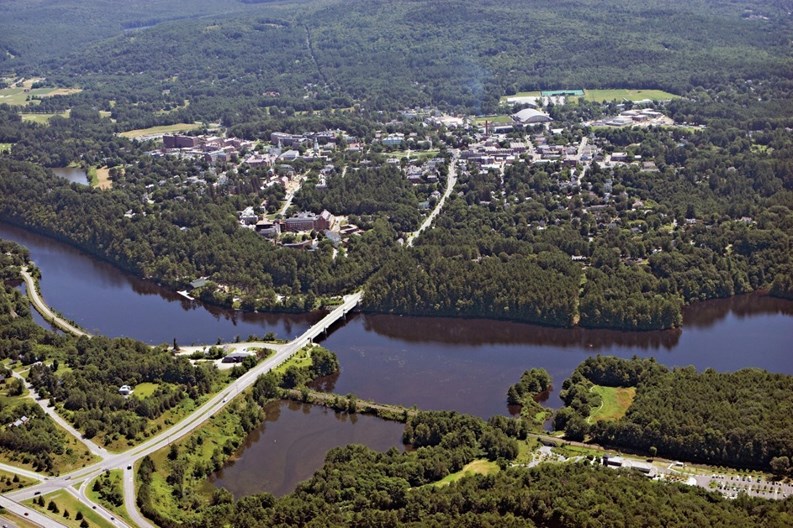Perched on the banks of the Connecticut River and a stone’s throw from Vermont rests the town of Hanover, New Hampshire. With an Ivy League college, a hospital and the Appalachian Trail all finding their place in or their way through the community, Hanover has distinct privileges and responsibilities that make it both an unusual and desirable place to live.
Self-Sufficiency
When asked about Hanover’s attractions, Janet Rebman, executive director of the Hanover Area Chamber of Commerce, headquartered in the heart of Hanover, said without missing a beat, “It’s easier to tell you what Hanover doesn’t have than what we do have, because we have everything.” She was not averse to rattling off a long list of genuinely appealing-sounding town attributes, with one qualification. “You have to like winter,” she admits, noting that this season usually lasts five to six months in that area.
There are ski areas galore within an hour or less of Hanover, and cross-country skiing and snowshoeing are also popular winter pastimes. But, she points out, for less outdoorsy types, there are also indoor sports available, gyms and spas, as well as the arts and more intellectual pursuits: from lectureseries to poetry to quilting to woodcarving.
The chamber’s website lists even more activities, breaking many of themup seasonally, as if to show first of all that Hanover really does have all four seasons, and more than that, that each season is a good one to be there.
Another draw to the town is the highly competitive education. Not only does the town boast an Ivy League college in Dartmouth, but “we are blessed with an extraordinary school system,” says Rebman, “ ... with an extraordinarily high graduation rate.” College recruiters take note of graduates from within the local school district. Asfor Dartmouth, its Ivy League label speaks for itself. The school is proud of both its personal feel and its intellectual excellence, and the college is perhaps the town’s greatest economic and cultural stimulus.
“What we don’t have,” Rebman saysalmost proudly, “is a city. We're a true New England town. We have a Main Street. We have artists and authors and a lot of those types who tend to want to get out of the city and want to live in, in my opinion, one of the greatest gems out there.”
A Broader Identity
Hanover is located just north of the junction of Interstate Highways 89 and 91, in what is known as the Upper Valley. The population stood at about 10,850 as of the 2000 census. In 2007, CNN and Money magazine rated Hanover the second best place to live in America. (Middleton, WI was first.)
Hanover and neighboring Lebanon serve as the New Hampshire centers for this region, while Norwich and White River Junction provide a regional center for Vermont. Routes 10, 10A and 120 afford access and outlets, and a shuttle bus company called “Advance Transit” offers free shuttle rides to anyone in the Upper Valley Region. The company reports, “System-wide free service has been made possible by special increased contributions from Upper Valley towns, Dartmouth College, and the Dartmouth-HitchcockMedical Center.” Advance Transit (also known, like the Appalachian Trail, as “AT”) likewise provides and organizes ridesharing opportunities and is working to become more accessible to people with disabilities.
The towns of the Upper Valley share a unique relationship with each other that goes far beyond the sharing of transportation. The Hanover Area Chamber of Commerce serves towns inboth New Hampshire and Vermont, as does the school district. At one time in its earlier history, Hanover and neighboring towns considered seceding from their respective states and forming a new one, but in the end, Vermont and New Hampshire remained intact, but the towns in question retained their close, collaborative relationship.
As for the college, its vision is even broader, enabling this “true New England town” to reach far beyond the confines even of two states. In an open letter, Dartmouth’s president, Jim Yong Kim, says, “At Dartmouth, we set very high aspirations, and what we do has a global impact.”
Where the Heart Is
Not everyone is comfortable with Hanover’s new horizons and directions, however. One longtime resident complains that the small town community feeling in Hanover has eroded over the years, along with affordable housing near the Dartmouth campus. Although she bought her house when times were easier, and still loves living in a place where she can walk to work and send her children to good schools, she laments the loss of small-town atmosphere. A former resident, on a return visit to the town, lamented the contemporary, institutional feel of newconstruction among the picturesque older architecture of the town.
Ned Redpath, broker/owner of Coldwell Banker – Redpath & Co., Realtors, with offices in both Hanover and in Quechee, Vermont, has no complaints about the Hanover lifestyle. He is sober about the real estate market, however. Although he suspects his company is probably the top real estate agency in the area, like everyone else, it has been down in sales for the last five years. The greatest burden, he says, is getting rid of inventory, as well as sellers supposing they can still receive their preferred asking price. According to Mike Ryan, the town assessor, in 2010 the number of single-familyhomes is 2,005, with a median purchase price of $493,800. The median purchase price of condo-miniums, of which there are 434 in town, is $279,000.
Redpath recommends offering “shock value reductions,” to startle consumers into realizing how affordable housing is now. He recognizes, on the other hand, that consumers are afraid of losing jobs, or of the rumored second dip in the economy. Nevertheless, some consumers are starting to nibble at the bait. “We remain, and we should in our business, be very optimistic,” he says. “We try to be in place, advise and educate, and try to be as soft as we can, but the consumer needs to be educated as to what’s really going on.” He also acknowledges that “we’re pretty lucky to be in the market we’re in. We’ve got a great hospital, a great college, a great lifestyle. We probably haven’t dipped as low as some other communities.”
New Strategies
Meanwhile, new architecture and shifting community aside, some townsfolk are finding creative new ways to reach out to care for their businesses, their environment and each other. An April panel discussion among business owners – summarized for the town by Erica Fairhurst, marketing services manager of the Chamber of Commerce – revealed that many are implementing new strategies to be easier on the environment and, ultimately, on their own bottom lines. Hypertherm, a manufacturer of plasma cutting systemsfor industry and one of the leading employers in the area, has a zero-waste goal and has already seen major savings as they begin to implement new environmental practices.
Perhaps most striking, however, is the new Gile Hill development, “Hanover’s newest, greenest residential community.” Although the lines and design of the buildings may be something to make an architectural traditionalist cringe, there is no doubt that the units offer stunning views and are made of unusual materials. Set right into the woods, these highly energy-efficient homes have been constructed in part from local materials. The siding was sourced from the trees on the construction site, and foundations weremade on-site from boulders that had been cleared to make way for houses.
Perhaps even more remarkable than the high-quality, environmentally-friendly construction is the history of how this development came to be. It was in 1999 that a man named Bob Strauss discovered there was no affordable housing for his church to rent for a refugee family. The incident spurred him and other Hanover residents to create the Hanover Affordable Housing Committee, now the Hanover Afford-able Housing Commission. In 2003, a tract of land given to the town in the 1950s was in turn given by unanimoustown vote to a not-for-profit corporation, Twin Pines Housing Trust (TPHT), to develop for affordable housing.
TPHT Executive Director Bruce Pacht, says, “The neighborhood’s entrance road begins in Lebanon, crosses land owned privately by the Dartmouth-Hitchcock Medical Center, and ends in Hanover. Extensive negotiations among the neighboring municipalities, the region’s largest employer, and representatives of this multi-faceted housing project were necessary to work out all the details of the project’s main entrance road.”
In fact, the entire project has always been, and remains, as Pacht says, “complicated, but an exciting arrangement.” Gile Hill incorporates and blends affordable and market-rate housing, both rented apartments and bought condos. The condominium and rental projects are separate, but the market-value and affordable housing are mixed together. Affordable housing units might be moderately smaller than the others, and are usually terrace unitsinstead of lofts, but the types are not segregated by building.
Pacht describes his company’s role in the project: “As the local not-for-profit partner, TPHT will remain perpetually involved in the project. TPHT is the managing general partner of the limited partnership which owns the six rental buildings. TPHT is also the perpetual steward of the affordability of the 14 condominiums whose resale and equity gain are controlled by an affordability covenant.” The first phase of the project sold or rented outto 76 families. The second phase is ready for immediate occupancy, and when its 20 units are sold, the third and final phase will begin.
The face of Hanover may be shifting and changing, as it is for so many communities these days. If it retains a solid core of people who care about their environment and each other, however, it will continue to be a wonderfulplace to live for years to come.
Jennifer Grosser is a freelance writer and a frequent contributor to New England Condominium magazine.







Leave a Comment